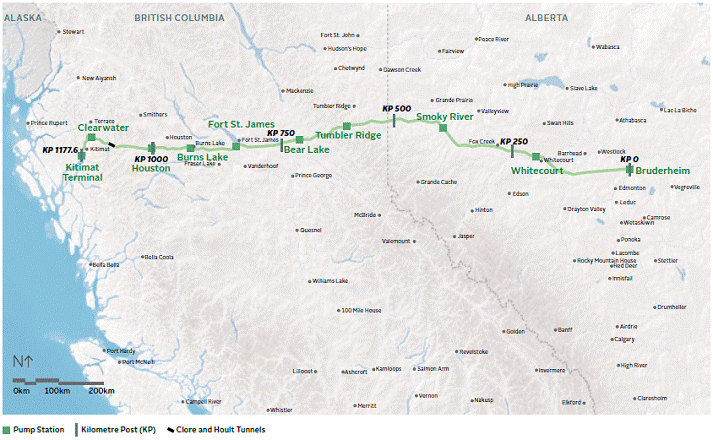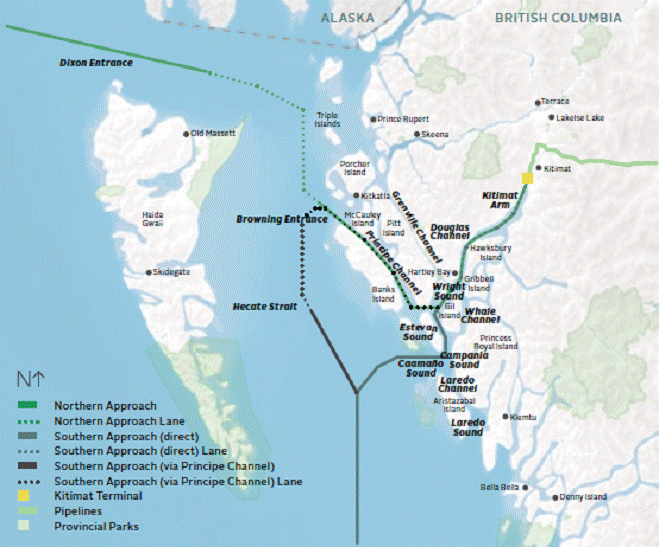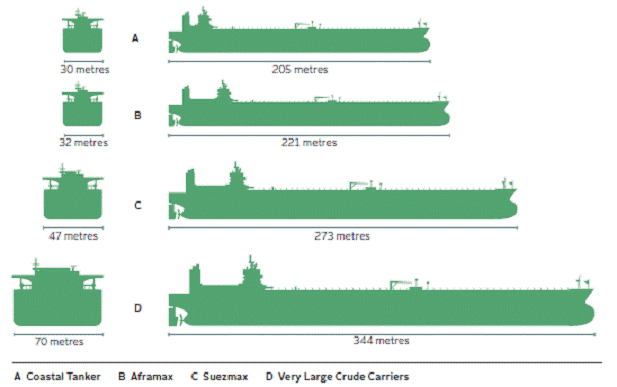|
| |
| 21. Dezember 2013 |
Das Joint Review Panel spricht sich für den Bau der Northern Gateway Pipelines
und den Öltankerverkehr entlang der Küste von BC aus. Risiken und Umweltgefahren
werden verharmlost, Wirtschaftsinteressen dominieren |
| |
| Am 19.12. 2013 hat das Enbridge Northern Gateway Project Joint Review Panel (JRP) seinen lange erwarteten Bericht vorgelegt und der kanadischen Regierung empfohlen, das Projekt zu realisieren. Premierminister Stephen Harper solle dem Bau der geplanten Pipelines zwischen Bruderheim/Alberta und Kitimat/BC sowie dem Öltankerverkehr entlang der Küste von BC zustimmen, da das Projekt im „öffentlichen Interesse“ sei und der Bau sowie der Routinebetrieb keine signifikant negativen Umwelteffekte verursache, sofern 209 (wachsweich) formulierte Bedingungen eingehalten werden. Zu diesen Bedingungen gehören u. a. das Einhalten der „freiwillig“ gegebenen Verpflichtungen (Marine Voluntary Commitments) in Punkto marine Sicherheit, die Vorlage eines Pipeline- und Marine Environmental Effects Monitoring Plan (eine bloße Dokumentationspflicht der zu erwartenden Negativeffekte), eines Marine Mammal Protection Plan, eines Caribou Habitat Restoration Plan, eines Notfallplans für den Fall einer Ölpest und Bauvorschriften für die Pipeline. Premierminister Harper und sein Kabinett haben jetzt
180 Tage Zeit, um das Projekt abzusegnen. Harper, ein glühender Verfechter des Projektes, hat sich längst dafür entschieden und wird möglichst rasch den Empfehlungen des JRP zur Realisierung des Northern Gateway Projektes folgen. 7 Tage nach der Entscheidung Harpers wird das National Energy Board (NEB) dem Enbridge Northern Gateway Projekt seine „certificates of public convenience and necessitiy“ ausstellen und das Projekt kann dann endgültig begonnen werden. |
| |
 |
| Die Pipelineroute des Northern Gateway Projektes |
© Considerations. Report of the Joint Review Panel for
the Enbridge Northern Gateway Project. Volume 2. |
|
| |
| In der offiziellen Presseerklärung des JRP vom 19.12.2013 (Joint Review Panel recommends approving the Enbridge Northern Gateway Project) heißt es: „The Joint Review Panel (the Panel) for the proposed Enbridge Northern Gateway Project today recommended that the federal government approve the project, subject to 209 required conditions. Based on a scientific and precautionary approach to this complex review, the Panel found that the project, if built and operated in compliance with the conditions set out in its report, would be in the public interest. |
| The Panel also recommended that the Governor in Council determine that the construction and routine operation of the project would cause no significant adverse environmental effects, with the exception of cumulative effects for certain populations of woodland caribou and grizzly bear. In these two cases, the Panel found that cumulative effects as a result of this project and other projects, activities or actions are likely to be at the low end of the range of possible significance. The Panel recommended that these effects be found to be justified in the circumstances. |
| The Panel concluded that the environmental burdens associated with project construction and routine operation can generally be effectively mitigated and that continued monitoring, scientific research and adaptive management could further reduce adverse effects. |
| The Panel stated that ‚the environmental, societal and economic burdens of a large oil spill, while unlikely and not permanent, would be significant‘. The Panel found that Northern Gateway had taken steps to minimize the likelihood of a large spill through its precautionary design approach and its commitments to use innovative and redundant safety systems. The Panel also found that, after mitigation, the likelihood of significant adverse environmental effects resulting from project malfunctions or accidents is very low. |
| The Panel found that ‚opening Pacific Basin markets is important to the Canadian economy and society‘. The Panel also found that ‚the project would bring significant local, regional, and national economic and social benefits‘. |
| After weighing all of the oral and written evidence, the Panel found that Canada and Canadians would be better off with the Enbridge Northern Gateway project than without it. |
| The Panel’s conditions, which would be enforced by the National Energy Board, include requirements for Enbridge Northern Gateway to: |
- Develop a Marine Mammal Protection Plan;
- Implement the TERMPOL Review Committee Recommendations;
- Prepare a Caribou Habitat Restoration Plan;
- Develop a Training and Education Monitoring Plan;
- Prepare an Enhanced Marine Spill Trajectory and Fate Modelling;
- Develop a Research Program on the Behaviour and Cleanup of Heavy Oils;
- Conduct Pre-operations Emergency Response Exercises and Develop an Emergency Preparedness and Response Exercise and Training Program.“
|
| Den kompletten zweibändigen Bericht des JRP finden Sie unter: http://gatewaypanel.review-examen.gc.ca/clf-nsi/dcmnt/rcmndtnsrprt/rcmndtnsrprt-eng.html |
| Insbesondere der erste Band des Berichts liest sich wie eine Werbeschrift des Enbridge-Konzerns für das Northern Gateway Projekt, es werden unkommentiert die Versprechungen der Enbridge Inc. übernommen, ohne sie in Frage zu stellen. |
| |
 |
| The proposed site for the terminal facility is on the northwest side of Kitimat Arm of Douglas Channel. Tankers could follow several possible routes to and from the terminal. The routes would pass through waters used by Aboriginal groups, commercial and recreational fisheries, sailors and kayakers, tourist vessels, ferries, and other shipping. |
Die geplanten Tankerrouten des
Northern Gateway Projektes |
© Considerations. Report of the Joint Review Panel for
the Enbridge Northern Gateway Project. Volume 2. |
|
| |
| Das JRP, bestehend aus drei Mitgliedern (Sheila Leggett, Kenneth Bateman, Hans Matthews) bezeichnet sich zwar offiziell als „unabhängig“, wurde jedoch vom National Energy Board und dem kanadischen Umweltminister beauftragt, den jetzt vorgelegten Bericht auszuarbeiten, d. h. ein Gefälligkeitsgutachten zu erstellen. Die jetzige Entscheidung mit dem Potential für verheerende und irreversible Umweltschäden war deshalb keine Überraschung. Das Budget des National Energy Board kommt zu etwa 90 % aus der Zusammenarbeit mit Konzernen wie z. B. der Enbridge Inc., die das Northern Gateway Projekt realisieren will. Obwohl sich bei den Anhörungen zum Projekt zwischen Januar 2012 und Juni 2013 96 % in schriftlichen Stellungnahmen gegen das Projekt ausgesprochen haben, setzte sich das JRP in autokratischer Manier über diese Mehrheit hinweg. 160 vom Pipelinebau betroffene First Nations, 31 betroffene Stadt- und Gemeindeparlamente in BC, zwei Regionaldistrikte, 6 Gewerkschaften, Kirchen, die Union of B.C. Municipalities und unzählige andere Vereinigungen hatten sich klar gegen das Projekt ausgesprochen. Zuletzt stärkte noch die Lehrervereinigung von BC, die BC Wilderness Tourism Association und die Canadian Association of Physicians die Allianz gegen das Projekt, indem sie die „Save the Fraser Declaration“ mit unterzeichneten. Selbst die Provinzregierung in BC hatte im Mai 2013 gegenüber dem JRP erklärt, dass sie die Pläne zum Northern Gateway Projekt in ihrer jetzigen Form aus Umweltschutzgründen ablehnt. Meinungsumfragen in BC zeigen immer noch, dass die breite Bevölkerungsmehrheit das Projekt ablehnt. Das JRP hat mit seiner zu erwartenden selbstherrlichen Gefälligkeitsentscheidung zugunsten der Ölindustrie die Demokratie in Kanada mit Füßen getreten. Für die Demokratie war dies ein rabenschwarzer Tag, an dem das „öffentliche Interesse“ mit den Interessen der Ölindustrie gleichgesetzt wurde. Eine Gleichschaltung des „nationalen Interesses“ Kanadas mit den Profitinteressen der Ölindustrie bei ihrer Suche nach neuen Märkten ist mehr als bedenklich. Für die Umwelt markiert dieser Tag mit hoher Wahrscheinlichkeit das Herannahen einer Katastrophe noch ungeahnten Ausmaßes, nicht nur entlang der Pipeline- und Tankerroute, sondern auch in den Abbaugebieten der Öl- bzw. Teersande in Alberta. |
| |
 |
| Größen von Tankertypen, die im engen Douglas Channel zum Einsatz kommen sollen (engste Stelle: 1350 Meter). Je nach Größe werden es jährlich 220 bis 250 Tanker sein. Der Supertanker (Very Large Crude Carrier) Knock Nevis hat z. B. eine Länge von 458 m und eine Breite von 69 m – deutlich mehr als es das JRP angibt |
© Considerations. Report of the Joint Review Panel for the Enbridge Northern Gateway Project. Volume 2. |
|
| |
| In seiner unmittelbaren Reaktion auf die Entscheidung des JRP für das Projekt schreibt Ian McAllister von Pacific Wild: „Todays National Energy Board decision to approve the Northern Gateway oil pipeline is being met with outrage and frustration by people across Canada as the 209 recommendations outlined in the report continue to be analyzed. ‚It is inconceivable how the NEB could dismiss the impacts that an oil spill could have on the B.C. coast as being ‚significant‘ but not ‚permanent‘, while Alaskans are still living with the devastation to their coastal environment caused by the Exxon Valdez disaster more than 20 years later‘ … The NEB has included 209 conditions, including a vague marine mammal protection plan, enhanced marine spill measures and other requirements. There are no mitigation measures that can manage the impact that this project would have on whales and the marine environment. Further, none of the conditions address the adverse social, health or cultural impacts that this project has already had, and will continue to have on coastal communities as long as the threat of this project exists. The project is also described as being in the public interest, and therefore outweighs environmental impacts and wildlife protection. This flies in the face of the evidence that was submitted to the Panel throughout the duration of the process. 95 % of public submissions to the Panel were in opposition to the project and countless polls indicate the majority of British Columbians are strongly opposed to oil tankers in the Great Bear Rainforest. Additionally, over 130 First Nations signatories to the Save the Fraser Declaration have band tars sands bitumen from crossing their traditional territories. ‚The NEB does not regulate projects such as Northern Gateway, it facilitates them‘, said McAllister. ‚And considering that 90 % of the National Energy Board’s budget comes from corporations like Enbridge and historically they have approved nearly every single project, this decision does not come as a surprise.‘ This is a shameful day for Canada, our democracy and our coastal ecosystem. Pacific Wild Alliance is committed to ensuring that the Great Bear Rainforest remains tanker free, and we will continue to work within the region and with supporters around the world to protect the wild coast we love.“ (National Energy Board Dismisses British Columbia’s Opposition: years of litigation, civil disobedience and controversy will follow. Presseerklärung vom 19. Dezember 2013, Ian McAllister, Pacific Wild). |
| Das JRP fasst wichtige Fakten zum Northern Gateway Projekt zusammen: „Northern Gateway applied to the National Energy Board on 27 May 2010 for authorization to construct and operate a new transportation route for Canadian oil products to reach world markets. It would have three major components: |
- one 914 millimetre (36 inch) outside diameter pipeline would carry an average of 83,400 cubic metres (525,000 barrels) of oil per day west from Bruderheim to Kitimat;
- a parallel pipeline, 508 millimetres (20 inches) in outside diameter, would carry an average of 30,700 cubic metres (193,000 barrels) of condensate per day east from Kitimat to the inland terminal at Bruderheim; and
- a terminal at Kitimat with 2 tanker berths, 3 condensate storage tanks, and 16 oil storage tanks.
|
| The Bruderheim terminal would have connections to other pipelines serving producers and markets in Western Canada … The application identified a 1-kilometre-wide corridor for the proposed 1,178-kilometre-long route. The exact location of the pipelines’ shared 25-metre-wide right-of-way would be determined after detailed engineering if the project is approved. Ten pumping stations, including those at Kitimat and Bruderheim, would be located on the route. The total estimated capital cost of the project is $ 7.9 billion. Northern Gateway said that the project would be completed by late 2018. Once in operation, about 220 tankers would call at the Kitimat Terminal annually to deliver condensate or load oil products. The largest tankers would carry about three times as much oil as the tankers that have historically visited British Columbia ports. The westbound pipeline could carry a variety of refined and crude oil products. Studies prepared for the project indicate that the majority of shipments would be diluted bitumen, which is a blend of light and heavy oil products. Northern Gateway is a limited partnership registered in Alberta. It was formed in 2004 to build and operate the Enbridge Northern Gateway Project. Enbridge Inc., a major pipeline company, is currently the only shareholder in the project. Ten energy companies are Funding Participants that have together invested more than $ 140 million in developing the proposal; they would have options to get shipping capacity and equity (ownership shares) if the project goes ahead. Up to 10 per cent of the equity has been set aside for Aboriginal partners; Northern Gateway offered the equity package to 40 Aboriginal groups, and 26 accepted the offer.“ |
| |
 zurück zurück |
|
|



